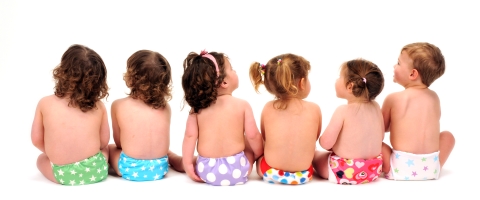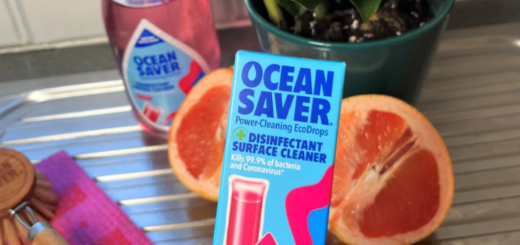Are real nappies greener than disposables?

Are real nappies greener?
Ethical Superstore unravels the government report on reusables vs. disposables for Real Nappy Week – which are the greenest?
The first government report suggesting “no significant difference” in environmental impact between reusable or disposable nappies, was speedily sent back to the drawing board a couple of years back for major revisions after campaign groups slandered it as being “seriously flawed”.
Then, finally, last October, came the revised report nappy-users had been waiting for. Yet, if you read the media reports surrounding the findings, no one would blame you for being left somewhat perplexed as to which was the ethical option.
Depending on which media coverage you read, parents portrayed as too-posh-to-Pamper were reviving trendy reusables, yes, but through using them, were oozing tonnes more CO2 into the atmosphere than those parents popping disposables on their nippers. Those in the green corner, however, were heralding reusables as being 40 per cent better for the environment – all based on the same government report findings.
So where is the truth? As usual, it lies somewhere in the middle.
Crucially, the updated report had taken into account a broader range of user behaviours for reusable nappies than first time around in order to give a more accurate representation, which is of course, good news.
But unfortunately, the user behaviours in the study tended to lean towards the extremes. Real nappy users are polarised as either modern mamas addicted to heat and tumble drying, or hippies happily hanging out nappies to dry outside – whatever the weather. The former having a higher CO2 footprint than a disposable user over the two and a half year nappy-wearing period, the latter a much lower one.
It might come as no surprise then to know that using high temperatures of 90 degrees to wash, and always tumble drying has the highest carbon emission according to the report due to, wait for it, “increased electricity consumption” – ahem. In carbon terms, it’s 80 per cent more expensive than using disposables.
I wonder how many real nappy users can relate to this high-energy approach?
Opting to line dry, however, and have more ‘efficient washing loads’ (in report terminology, this means owning more nappies and washing every three days rather than two) reduces the carbon emissions by 38 per cent compared to disposables. Choosing to pass on your nappies reduces the impact further still.
So, it’s key to note their so-called ‘high energy efficiency’ category – which means you simply wash at 60 degrees, have average tumble drying use, and use an A+ rated washing appliance – will be greener than the average disposable user. And perhaps, most significantly, even the average real nappy user (who according to the report washes at 60, averagely tumble dries but does not possess an A+ appliance) only has to pass on their nappies once in order to have less of an environmental impact than the average disposable user.
So, if you are at least as energy-efficient as the reports’ ‘high energy efficiency’ user or choose to pass them on, then real nappies are the greenest way to go.
One major fault with the report is it doesn’t bring into play the fact that nappies could be mixed with other laundry loads which saves on energy considerably. What parent doesn’t shove in a few extra items in a load to economise? This would bring down CO2 further. The report is also based on using ‘shaped’ reusable nappies only, and these are notoriously tougher to dry than say, pre-fold nappies confounding matters further.
And, as far as disposables go, the report reduced their manufacturing impact by 13 per cent from the previous study – based on information provided by the disposable nappy industry – as nappies have become “less weighty”. However, the fact that increased usage might follow due to lower quality was not taken into consideration and nappy numbers were based on the previous studies’ figures. The CO2 emission could in fact be more than the stated 550 kg per user.
As before, the report is someway towards helping us decide the greenest option, but read between the lines and I hazard a guess that simple green, not to mention economic, reasoning would guide you to the greenest way to care for your reusables and hence sway you to opt for the real nappy deal and go real.
Find out how real nappies are the cheaper option to disposables by up to £600.
Any questions on using real nappies? How do you wash and dry your reusables nappies – any tips to save energy? Comment below.



More and more of us are now thinking creatively about how we can reuse what we have bought, and more people are recognising the very real advantages and opportunities offered by recycling.
We can now see that by transforming the way we think and act, we can change our waste into something useful, reusable and responsible. By treating waste as a resource, we can transform it into something positive and ultimately chanmge our environment. There is no doubt that is the kind of change that will do us all good. But how does this relate to real nappies I hear you ask?
Well, the simplest kind of change that any family can make isn their choice of nappy. Here in Wiltshire around 6% of all household waste that ends up in landfill is made up of disposable nappies and whilst changing nappies may not be the most pleasant experience it does need to be done quite a few times in the day so why not put something comfortable and chemical free next to your baby’s skin?
The prevailing myth about real nappies is that they are difficult to use, smelly and unpleasant to wash. This is far from the truth. The design of modern cloth nappies is such that they are easy to put on, easy to wash even at temperatures as low as 30 degrees thanks to the new washing powder, Potion, from Tots Bots.
The benefits of using cloth nappies are
(1) They reduce waste – currently around 8 MILLION nappies a day go to landfill sites around the country
(2) Real nappies cut the cost to local tax payers for collection and disposal
(3) Use fewer raw materials
(4) Prevent waste at source
(5) Help reduce production of landfill gases such as methane by using the sewage system for faecal waste
On a personal level, I have never used disposables on either of my children and found that even with both my wife and I working full time and with the children looked after by a child minder (who incidentally had no aversion to using the cloth nappies) we managed to used them full time all the time and saved quite a bit of money!
I would encourage anyone who is thinking about using real nappies or who does not believe that they could work for them to get in touch with your local nappy network or council for example to ask any questions you may have.
Thank you for taking the time to read this and I hope you make the natural choice.
If disposable nappies have no greater environmental impact than washable nappies, why are other items of clothing not also disposable? The carbon footprint of manufacturing, washing and drying clothing compared to the carbon footprint of manufacturing and disposing of throwaway clothes should be compared, and if they are really comparable we should all be wearing paper clothes too! Disposable nappies are no more sensible than any other item of disposable clothing – nappies are no more than underwear.
Does the government report comparing disposable and washable nappies take into account their environmental impacts after use, including collection, landfill or incineration, methane production and pollution by raw sewage?